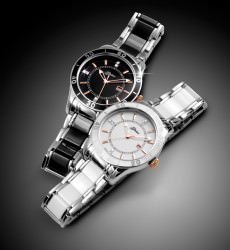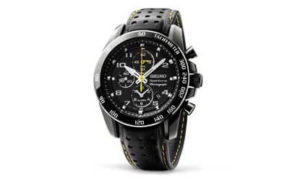Market Watches
The value proposition for watches is in genuine design and innovation, as well as the personal expression and sentiment timepieces hold. Watches have transcended their basic function of time telling to become image-makers, status symbols and must-have fashion accessories for men and women.
 U.S. watch market trends offer a diverse mix in styles, including an embrace of classic, sleeker, thinner looks for men. Emerging for women are extremely artistic designs like miniature jewels on the wrist, and more mechanical styles (most brands now have tourbillons, and minute repeaters are revived as a hot new complication in special, technically advanced ways).
U.S. watch market trends offer a diverse mix in styles, including an embrace of classic, sleeker, thinner looks for men. Emerging for women are extremely artistic designs like miniature jewels on the wrist, and more mechanical styles (most brands now have tourbillons, and minute repeaters are revived as a hot new complication in special, technically advanced ways).
Fashion has a big impact in the watch category, especially among younger consumers who own more watches than any other age group today, despite their smart devices. Demand is growing for better-styled, higher quality timepieces, with the integration of alternative materials like carbon fiber, rubber, ceramic, wood, mother-of pearl, leather, and liquidmetal, often with stainless steel and gold, pink preferred.
Effective merchandising techniques can increase sales and profitability for your watch inventory. Top of the list: engaging customers to touch, feel and try on. Positioning and placement of watches within the store are paramount. Avoid cluttering cases; it hurts the value perception. Make displays easy to view, and incorporate visuals that reflect the image you want to portray. Make sure it meets the attention, interest and desire criteria. Center key features, categories and collections in the display. Throughout the showcase, consider grouping similar features such as diamond dials and cases. Also, try mixing watches with jewelry styles that share characteristics like gold watches with gold jewelry.
 “Retailers today have a difficult job in merchandising and marketing watches,” empathizes Roberta Naas, veteran watch journalist and founder of atimelyperspective.com. “You must have a selection diverse in price and style that will cater to your local market. Faced with all the new products and brands available, retailers must really know their customers to make the very best decisions in what to stock and how to market it to them.”
“Retailers today have a difficult job in merchandising and marketing watches,” empathizes Roberta Naas, veteran watch journalist and founder of atimelyperspective.com. “You must have a selection diverse in price and style that will cater to your local market. Faced with all the new products and brands available, retailers must really know their customers to make the very best decisions in what to stock and how to market it to them.”
Watches should be a part of a jeweler’s offerings, advocates watch and jewelry retail consultant Steven Kaiser of Kaiser Time Inc. The product’s position as the most important accessory for men, and an increasingly popular fashion choice for women have elevated watches to what Kaiser believes is a top category for jewelers. He notes that watch brands bring international cache, add prestige, provide a comfort level to new customers, generate traffic, and increase sales.
 Successful watch brands help their retailers create in-store excitement. A great example is in Citizen’s Trade In, Trade Up program. Designed for its independent retailers, the program’s aim was to increase store traffic and sales during the normally slower months of September and October last year. Consumers traded in an old watch for a $25 to $50 credit toward the purchase of a new Citizen Eco-Drive watch. To promote it, Citizen provided retailers with posters, counter cards, email blast, digital banners, and radio scripts. Dana Bell, spokesperson for Citizen, hailed it a great success. “We encourage our retailers to promote our brand and piggyback on our extensive advertising campaign, which gives them easy access to layouts for current nationally advertised models. We realize the power of our brand is amplified through cooperative advertising programs.”
Successful watch brands help their retailers create in-store excitement. A great example is in Citizen’s Trade In, Trade Up program. Designed for its independent retailers, the program’s aim was to increase store traffic and sales during the normally slower months of September and October last year. Consumers traded in an old watch for a $25 to $50 credit toward the purchase of a new Citizen Eco-Drive watch. To promote it, Citizen provided retailers with posters, counter cards, email blast, digital banners, and radio scripts. Dana Bell, spokesperson for Citizen, hailed it a great success. “We encourage our retailers to promote our brand and piggyback on our extensive advertising campaign, which gives them easy access to layouts for current nationally advertised models. We realize the power of our brand is amplified through cooperative advertising programs.”
Part of the brand power is also in celebrity and charity connections that can influence purchase decisions. Recent marketing campaigns for Seiko, for example, include programs with national soccer icons Landon Donovan and Hope Solo, as well as charities like the American Heart Association’s “Go Red For Women” movement. “These campaigns are marketed throughout the country on a local retailer level, keeping consumers engaged with the Seiko brand,” explains company spokesperson, Kathleen LeFebvre.
Kaiser advises jewelers follow the brand’s lead when it comes to merchandising and marketing their watches. “If I’m a jeweler and choose a brand to carry, why reinvent the wheel? The best thing to do is to keep things simple. Brands invest a lot in product development and marketing. Listen to what the brand says.” He notes that while some brands may seem controlling and restrictive, they’ve done the legwork to sell their products so capitalize on their research.
 Since the watch category is characteristically very traditional, there is a real opening for innovative marketing ideas, advocates Tricia Norton, global chief marketing officer for Bulova. “We see an opportunity to leverage visual social media platforms, like Instagram and Pinterest in a way that the watch world has not yet embraced,” she describes. “Social media’s innovative platforms and malleable programs will play a much larger role in marketing for the category.”
Since the watch category is characteristically very traditional, there is a real opening for innovative marketing ideas, advocates Tricia Norton, global chief marketing officer for Bulova. “We see an opportunity to leverage visual social media platforms, like Instagram and Pinterest in a way that the watch world has not yet embraced,” she describes. “Social media’s innovative platforms and malleable programs will play a much larger role in marketing for the category.”
Digital marketing and social media is all about engagement, while always being fresh and innovative, emphasizes LeFebvre. “It’s not just about having a Facebook page, it’s about staying a step ahead to ensure that we’re always creating and distributing content that consumers will find more engaging.” She encourages retailers to use social channels on a local level to share brand campaigns within their stores. “Always be one step ahead in this ever-growing industry of digital and social media.”
While brands dominate the watch category there is a trend for private label collections among jewelers identifying watch styles under their own name, capitalizing on their longstanding reputation to protect and increase their margins and overall store image. This trend may become more relevant as some brands move to vertical distribution through owned and operated boutiques. But Kaiser says jewelers successful with private label typically carry some recognized watch brands, which he considers traffic builders and sales generators for retailers.







